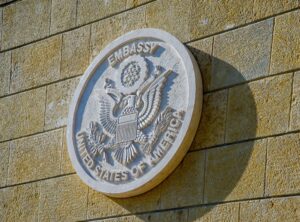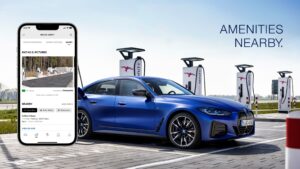Low Emission Bus Zones extended to seven locations
Seven ‘Low Emission Bus Zones’ are now in full operation in London, as part of the Mayor’s drive to reduce emissions of nitrogen oxides at roadside locations across the city.
The measure sees older, more polluting buses taken out of service on routes where levels of NO2 air pollution are known to be high, and replaced with retrofitted or newer models which meet the Euro VI emissions standard.

Mayor of London, Sadiq Khan, with pupils from Addey and Stanhope School this morning
LEBZs are now in operation from Camberwell to New Cross, Wandsworth to St John Hill, High Road Haringey to Green Lanes, A12 Eastern Avenue to Homerton Road and Edgware Road Kilburn to Maida Vale, joining existing zones on Brixton High Road and Putney High Street — a total of seven across London. 12 LEBZs are expected to be established across London in total.
Analysis published by TfL today suggests that the first two Low Emission Bus Zones have had a ‘major impact’ on pollution levels, with Putney High Street having recorded significantly fewer exceedances of the NO2 hourly limit so far in 2018 compared to previous years.
Retrofit
A total of £85 million is being invested across London to ensure that older buses are brought up to the Euro VI standard through exhaust retrofits, with buses that cannot meet the standard gradually being moved out of service.

A total of 12 LEBZs are planned
From April 2019, with the advent of the Ultra-Low Emission Zone, all buses operating in Central London will be required to be at Euro VI level, while City Hall has also targeted an October 2020 deadline for all TfL-operated buses across the city to meet the standard.
The Mayor launched the five new LEBZs on a visit to New Cross in South London this morning, where he met pupils from Addey and Stanhope School.

Only buses that meet the Euro VI emissions standards are permitted to stop on routes along the Low Emission Bus Zones
Speaking to airqualitynews.com, the Mayor said: “We saw in Putney and in Brixton that the hourly toxicity rates have been reduced by 85% and 95%, the amount of particulate matter and NOx coming from vehicles has reduced, so that is why I am really pleased today to be announcing a further five Low Emission Bus Zones.
“We are taking action to ensure that in the most polluted parts of our city, the air is being improved in the lead up to the World’s first Ultra Low Emission Zone in April. The whole ULEZ area will be one massive Low Emission Bus Zone, and so it is really important that we take action to clean up the air in London.”
Repeating his call for greater government support in tackling air pollution, including giving London councils access to funding through the £220 million Clean Air Fund, the Mayor added: “By ourselves we can’t do it. We are doing this with one hand tied behind our back, with the government having its head in the sand.
“What we need government to do is two major things. One is a diesel scrappage scheme to help those businesses, charities and low income families to move away from diesel to cleaner forms of transport, but two they need to allow London to have access to the Clean Air Fund, it is outrageous that given the number of polluted roads in London we cannot access the Clean Air Fund.”
Fund
Around 5,000 buses have been earmarked for cleaner technology retrofits through an £86.1 million programme announced by City Hall in 2017 (see airqualitynews.com story).

City Hall has an ambition to establish 12 low emission bus zones across the capital (Picture: @MayorofLondon)
Policies set out in the Mayor’s Transport Strategy also commit to the end of purchasing diesel-only buses for the capital, as well as committing to having 9,200 zero emission buses on the capital’s roads by 2037.
Ben Macdonald, Head of Year 11 at Addey and Stanhope school, commented that the policy would help to improve the health of pupils at his school.
He said: “Addey and Stanhope is located in the heart of Deptford. We love our location — however we are aware of the potential impacts of air pollution on our students and staff. The introduction of the Low Emission Bus Zone on New Cross Road will further help improve our local air quality and it shows that the Mayor is taking this issue seriously.”
London’s Low Emission Bus Zones project was the winner of the Passenger Transport Air Quality Initiative of the Year at the 2018 National Air Quality Awards (see airqualitynews.com story).
Related Links
Report – Low Emission Bus Zones: Evaluation of the first seven zones














